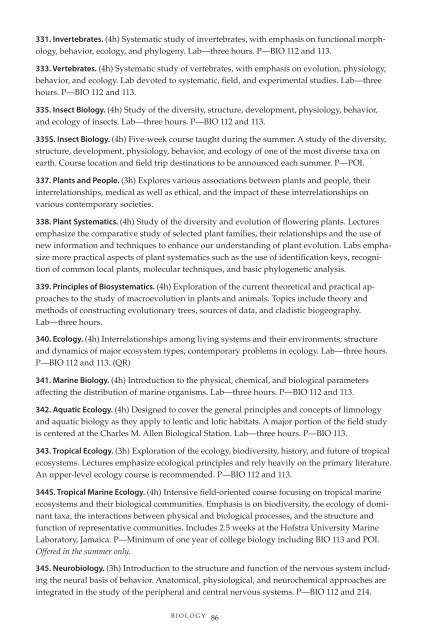theundergraduateschoo ls - Wake Forest University
theundergraduateschoo ls - Wake Forest University
theundergraduateschoo ls - Wake Forest University
You also want an ePaper? Increase the reach of your titles
YUMPU automatically turns print PDFs into web optimized ePapers that Google loves.
331. Invertebrates. (4h) Systematic study of invertebrates, with emphasis on functional morphology,<br />
behavior, ecology, and phylogeny. Lab—three hours. P—BIO 112 and 113.<br />
333. Vertebrates. (4h) Systematic study of vertebrates, with emphasis on evolution, physiology,<br />
behavior, and ecology. Lab devoted to systematic, field, and experimental studies. Lab—three<br />
hours. P—BIO 112 and 113.<br />
335. Insect Biology. (4h) Study of the diversity, structure, development, physiology, behavior,<br />
and ecology of insects. Lab—three hours. P—BIO 112 and 113.<br />
335S. Insect Biology. (4h) Five-week course taught during the summer. A study of the diversity,<br />
structure, development, physiology, behavior, and ecology of one of the most diverse taxa on<br />
earth. Course location and field trip destinations to be announced each summer. P—POI.<br />
337. Plants and People. (3h) Explores various associations between plants and people, their<br />
interrelationships, medical as well as ethical, and the impact of these interrelationships on<br />
various contemporary societies.<br />
338. Plant Systematics. (4h) Study of the diversity and evolution of flowering plants. Lectures<br />
emphasize the comparative study of selected plant families, their relationships and the use of<br />
new information and techniques to enhance our understanding of plant evolution. Labs emphasize<br />
more practical aspects of plant systematics such as the use of identification keys, recognition<br />
of common local plants, molecular techniques, and basic phylogenetic analysis.<br />
339. Principles of Biosystematics. (4h) Exploration of the current theoretical and practical approaches<br />
to the study of macroevolution in plants and anima<strong>ls</strong>. Topics include theory and<br />
methods of constructing evolutionary trees, sources of data, and cladistic biogeography.<br />
Lab—three hours.<br />
340. Ecology. (4h) Interrelationships among living systems and their environments; structure<br />
and dynamics of major ecosystem types; contemporary problems in ecology. Lab—three hours.<br />
P—BIO 112 and 113. (QR)<br />
341. Marine Biology. (4h) Introduction to the physical, chemical, and biological parameters<br />
affecting the distribution of marine organisms. Lab—three hours. P—BIO 112 and 113.<br />
342. Aquatic Ecology. (4h) Designed to cover the general principles and concepts of limnology<br />
and aquatic biology as they apply to lentic and lotic habitats. A major portion of the field study<br />
is centered at the Charles M. Allen Biological Station. Lab—three hours. P—BIO 113.<br />
343. Tropical Ecology. (3h) Exploration of the ecology, biodiversity, history, and future of tropical<br />
ecosystems. Lectures emphasize ecological principles and rely heavily on the primary literature.<br />
An upper-level ecology course is recommended. P—BIO 112 and 113.<br />
344S. Tropical Marine Ecology. (4h) Intensive field-oriented course focusing on tropical marine<br />
ecosystems and their biological communities. Emphasis is on biodiversity, the ecology of dominant<br />
taxa, the interactions between physical and biological processes, and the structure and<br />
function of representative communities. Includes 2.5 weeks at the Hofstra <strong>University</strong> Marine<br />
Laboratory, Jamaica. P—Minimum of one year of college biology including BIO 113 and POI.<br />
Offered in the summer only.<br />
345. Neurobiology. (3h) Introduction to the structure and function of the nervous system including<br />
the neural basis of behavior. Anatomical, physiological, and neurochemical approaches are<br />
integrated in the study of the peripheral and central nervous systems. P—BIO 112 and 214.<br />
B I O L O G Y 86






